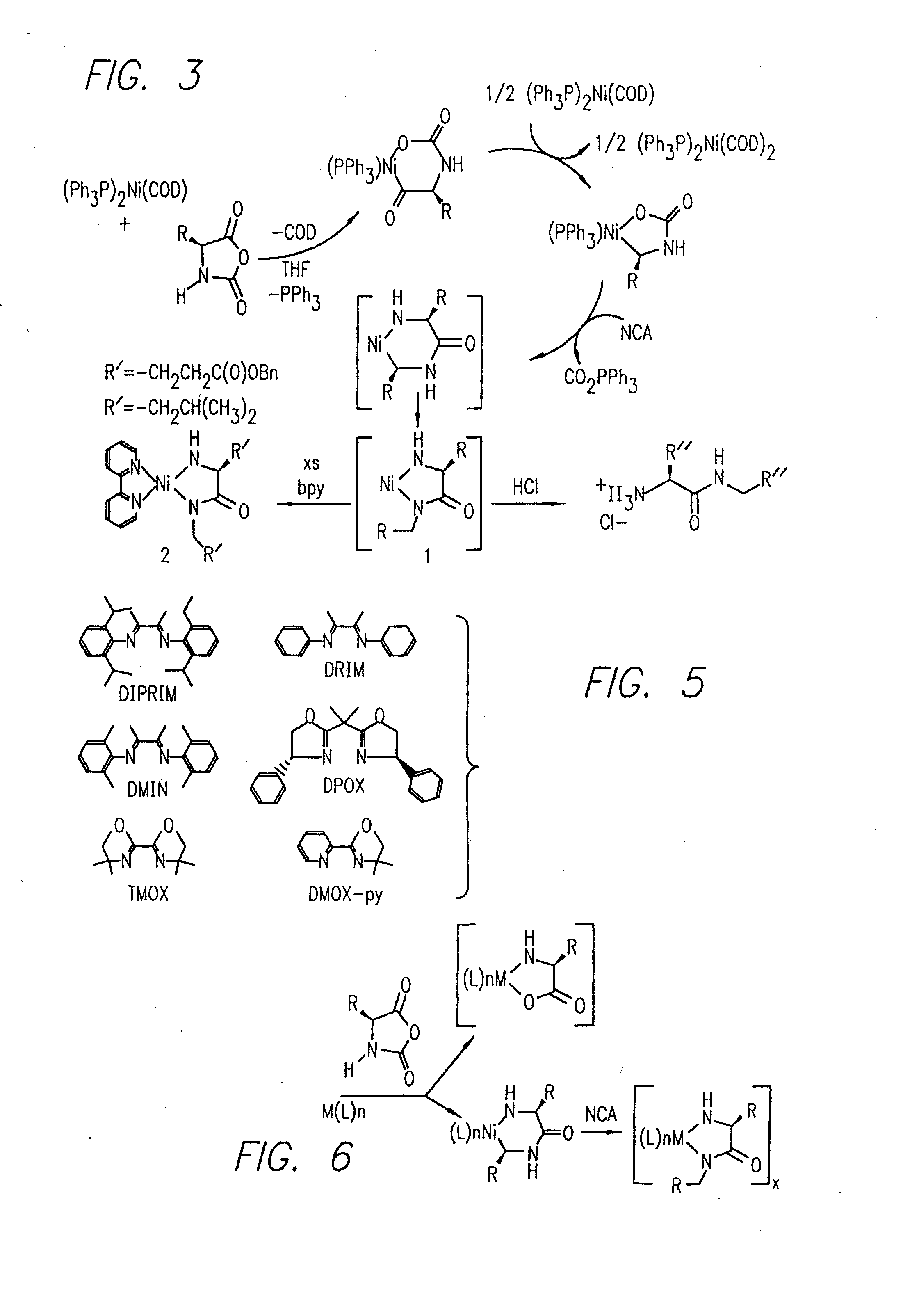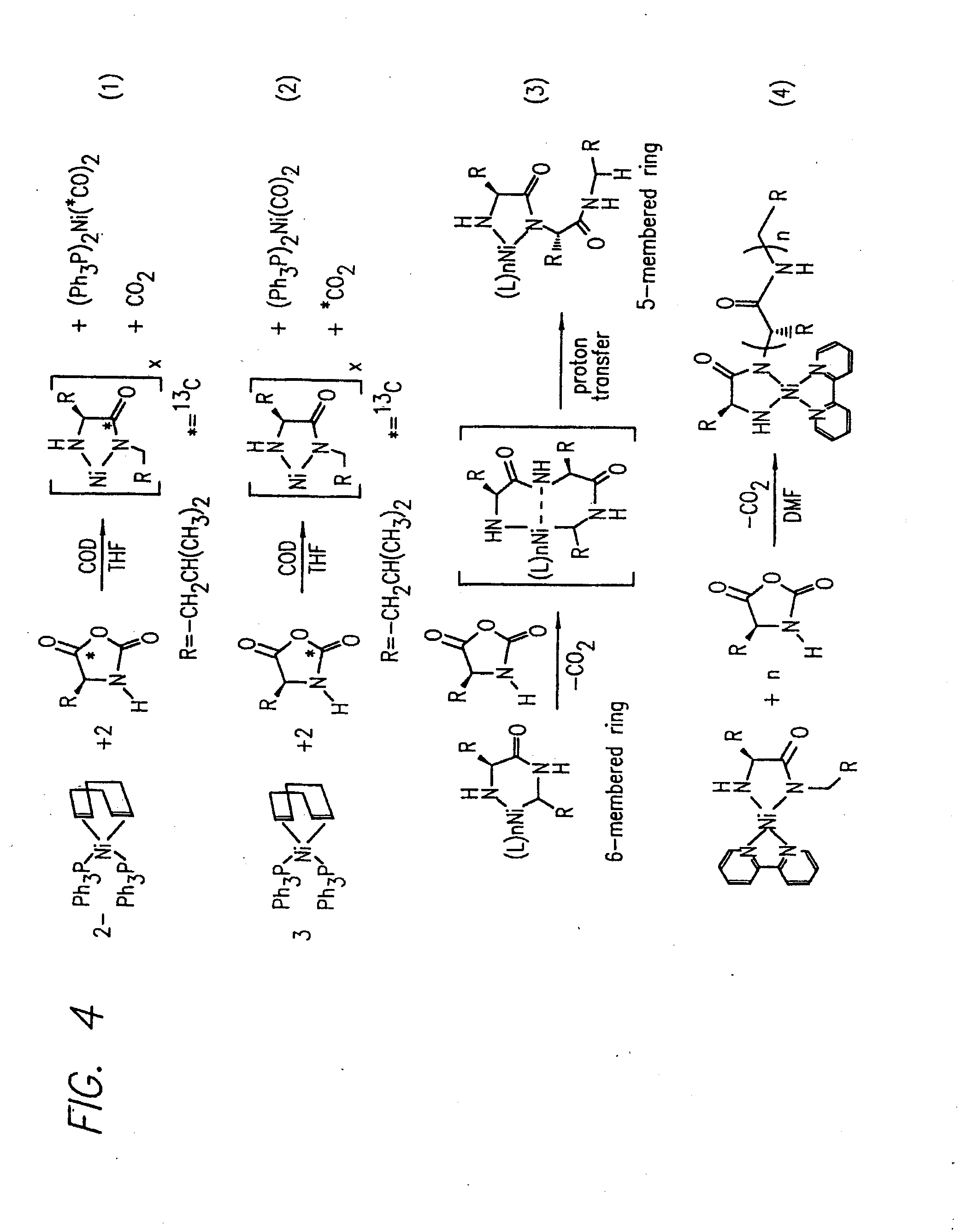Methods and compositions for controlled polypeptide synthesis
a polypeptide and polypeptide technology, applied in the direction of peptides, iron organic compounds, mechanical vibration separation, etc., can solve the problems of reducing the effective yield of desired products, no reaction proceeds to 100% completion, and imperfect reactions in the scheme, so as to eliminate chain-breaking side reactions
- Summary
- Abstract
- Description
- Claims
- Application Information
AI Technical Summary
Benefits of technology
Problems solved by technology
Method used
Image
Examples
example 1
Methods Using Amino Acid Derived Metallacycles: Intermediates in Metal Mediated Polypeptide Synthesis
[0151]General Experimental Protocols and Reagents
[0152]Infrared spectra were recorded on a Perkin Elmer 1605 FTIR Spectrophotometer calibrated using polystyrene film. Tandem gel permeation chromatography / light scattering (GPC / LS) was performed on a Spectra Physics Isochrom liquid chromatograph pump equipped with a Wyatt DAWN DSP light scattering detector and Wyatt Optilab DSP. Separations were effected by 105Å and 103Å Phenomenex 5μ columns using 0.1M LiBr in DMF eluent at 60° C. Optical rotations were measured on a Perkin Elmer Model 141 Polarimeter using a 1 mL volume cell (1 dm length). NMR spectra and bulk magnetic susceptibility measurements (Evans method) were measured on a Bruker AMX 500 MHz spectrometer. [D. F. Evans, J. Chem. Soc., 2003-2009 (1959); J. K. Becconsal, J. Mol. Phys., 15:129-135. (1968)]. C, H, N elemental analyses were performed by the Microanalytical Laborator...
example 2
Initiators for Chain-End Functionalized Polypeptides and Block Copolypeptides
[0172]Nα-allyloxycarbonyl-amino acid amides were reacted with zerovalent nickel complexes LNi(1,5-cyclooctadiene) (L=2,2′-bipyridine (bpy), 1,10-phenanthroline (phen), 1,2-bis(dimethylphosphino)ethane (dmpe), and 1,2-bis(diethylphosphino)ethane (depe)), to yield amido-amidate metallacycles of the general formula: LNiNHC(R′)HC(O)NR″. These complexes were found to initiate polymerization of α-amino acid-N-carboxyanhydrides (NCAs) yielding polypeptides with defined molecular weights, narrow molecular weight distributions, and with quantitative incorporation of the initiating ligand as an end-group. A napthyl substituent was incorporated as a fluorescent end-group to demonstrate the feasibility of this methodology.
[0173]General Experimental Protocols and Reagents
[0174]Infrared spectra were recorded on a Perkin Elmer 1605 FTIR Spectrophotometer calibrated using polystyrene film. Tandem gel permeation chromatogra...
example 3
Facile Synthesis of Block Copolypeptides of Defined Architecture
[0192]General Experimental Protocols and Reagents
[0193]Infrared spectra were recorded on a Perkin Elmer 1605 FTIR Spectrophotometer calibrated using polystyrene film. Tandem gel permeation chromatography / light scattering (GPC / LS) was performed on a Spectra Physics Isochrom liquid chromatograph pump equipped with a Wyatt DAWN DSP light scattering detector and Wyatt Optilab DSP. Separations were effected by 105Å and 103Å Phenomenex 5μ columns using 0.1M LiBr in DMF at 60° C. as eluent. Optical rotations were measured on a Perkin Elmer Model 141 Polarimeter using a 1 mL volume cell (1 dm length). NMR spectra were measured on a Bruker AMX 500 MHz spectrometer. Chemicals were obtained from commercial suppliers and used without purification unless otherwise stated. (COD)2Ni was obtained from Strem Chemical Co., and 13C1-L-leucine and 13C-phosgene were obtained from Cambridge Isotope Labs. g-Benzyl-L-glutamate NCA were prepare...
PUM
| Property | Measurement | Unit |
|---|---|---|
| diameter | aaaaa | aaaaa |
| Mn | aaaaa | aaaaa |
| polydispersity index | aaaaa | aaaaa |
Abstract
Description
Claims
Application Information
 Login to View More
Login to View More - R&D
- Intellectual Property
- Life Sciences
- Materials
- Tech Scout
- Unparalleled Data Quality
- Higher Quality Content
- 60% Fewer Hallucinations
Browse by: Latest US Patents, China's latest patents, Technical Efficacy Thesaurus, Application Domain, Technology Topic, Popular Technical Reports.
© 2025 PatSnap. All rights reserved.Legal|Privacy policy|Modern Slavery Act Transparency Statement|Sitemap|About US| Contact US: help@patsnap.com



